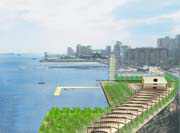Sandwiched between Sinatra and Castle Point Park is a piece of waterfront land owned by the Stevens Institute of Technology. The land, currently not accessible to the public, contains a university parking lot and tall green physical plant building that has jokingly been referred to in political circles as “Big John” because of talk that it’s a toilet and sink-testing facility. Now, the university has ambitious plans for under-utilized land.
As reported in November, the university wants to go forward with plans to build a state-of-the-art estuary center as well as a publicly accessible walkway. The working name of the project is the Center for Maritime Systems. According to Dr. Michael Bruno, the director of the Davidson Laboratory at Stevens, the center would create a collaborative atmosphere to bring together researchers, industry and government officials to address technical changes facing a maritime community.
Research would include testing of ship hulls in what would be the nation’s most advanced tidal pool. The center will also conduct research that will deal with issues of erosion and shoreline ecology.
It would mean the closing of the Davis Laboratory on Hudson Street between Sixth and Eighth Street.
The Davis Lab houses a huge aquatic tank that tests prototypes for boats and tests tidal conditions. Every boat that sailed in the Gulf War had a prototype that was tested at Davis Lab well before it was sea ready.
The new Harbor Estuary Center would be a long clear transparent building and would house a tank that would be used by the school and by the Department of Environmental Protection to test tidal conditions. Also, the Army Corps of Engineers would use it to test ships and civil engineering projects such as bridges. Approximately one third of the land where the Harbor Estuary Center is slated to be built will be used for a waterfront walkway and a publicly accessible park.
The Davis Lab will be torn down, and if the conceptual plan is completed, the school will build no more than 40 units of market-rate housing along Hudson Street, which would be taxable by the city and would produce revenue for Stevens.
The center will also deal with environmental issues that are unique to densely populated urban ports. These include heavy development along sensitive waterfront areas, eroding shorelines, water pollution from current and past sources, wildlife habitat loss, and siltation of navigation channels and ship berths, threatening the viability of the port.
According to Bruno, the center will be encircled by a public waterfront park and will offer education opportunities for residents and area school children. It will also have an area the will serve as an estuary and maritime exhibit, which would be open to the public.
The museum-quality public outreach and interpretive center will attract visitors from the city and the region. According to Stevens officials, the area will have revolving exhibits will keep the public informed of current research projects and will include the history of naval architecture at Stevens, including the historic model-testing at Davidson Labs of many vessels that have been sailed in the America’s Cup competition. Classroom space is also planed for the site.
Bruno said the Center for Maritime Systems will be an innovative way to connect Sinatra and Castle Point Park along the waterfront walkway. “This is a way to fill that gap with something that is unique and exciting,” said Bruno Wednesday morning.
The total cost for the project is an estimated $20 million. The U.S. Department of Education has shown its support for the concept by pledging a seed grant of $500,000 to be used to develop architectural plans for the center.
Stevens has already begun raising funds for the project as part of the school’s five-year, $102 million capital campaign. Private donations of $5 million are being sought on top of what the school anticipates to raise from government outlets and corporate support. “The Center for Maritime Systems will promote applied research aimed at safeguarding the environmental and economic vitality of the estuary and the port,” said Stevens President Dr. Hal Raveche recently. “This facility will be a vital addition not only to our campus, but will also benefit the general public from across the New York City region and beyond.”
The targeted date for completion of the facility is the latter half of 2004.
But not everyone in the community thinks such a large building belongs on the waterfront.
“What they have presented today, a 400 ft long building between Castle Point Park and Sinatra Park, would be a horrible mistake,” said Ron Hine, a principal in the Hoboken based Fund for a Better Waterfront, Wednesday. He added that the building was too large to place directly on the waterfront and belongs elsewhere on Stevens’ campus.
Others, like Mayor David Roberts, have come out in support of the project. “It’s a very exciting idea,” said Mayor Roberts Wednesday. “And I think it will be definitely preferable to what is there now.”
